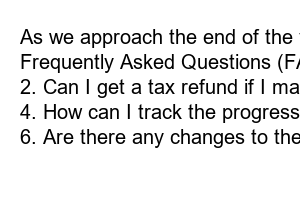연말정산 환급금 미리 보기
Title: Preview of Year-End Tax Refund: Maximizing Your Return
Introduction:
As the year comes to an end, it’s essential to look ahead and prepare for potential financial gains. Among the most anticipated moments for many is receiving their year-end tax refund. This blog post aims to provide you with a preview of what to expect, along with tips on how to maximize your return.
1. Understanding Your Tax Refund:
A year-end tax refund is a reimbursement of excess taxes you paid throughout the year. By overpaying your taxes, you are loaning the government money without interest. Come tax filing season, you can now recoup those funds.
2. Maximizing Deductions and Credits:
To ensure a higher tax refund, take advantage of every eligible deduction and credit. Deductions, such as medical expenses, mortgage interest, and student loan interest, can reduce your taxable income. Furthermore, credits like the Earned Income Tax Credit (EITC) and Child Tax Credit can provide a significant boost to your refund.
3. Planning Ahead for Next Year:
By making strategic financial decisions now, you can set yourself up for a larger tax refund in the future. Consider contributing to retirement plans, claiming appropriate allowances on your W-4 form, and exploring tax-advantaged savings accounts like IRAs and HSAs.
4. Avoiding Audit Triggers:
While maximizing your refund is essential, it is equally vital to steer clear of tax audit triggers. Be cautious of excessive deductions or credits that might raise red flags. Reporting all your income accurately and keeping meticulous records are crucial steps in avoiding audits.
5. Professional Assistance: Do I need it?
It can be daunting to navigate the complexities of tax regulations alone. Consulting a tax professional provides valuable expertise, ensuring that you don’t miss out on any tax-saving opportunities. From identifying deductions to ensuring proper documentation, a professional makes the process smoother and more efficient.
6. Common Mistakes to Avoid:
To optimize your tax refund, it’s essential to steer clear of commonly made mistakes. Examples include neglecting to file electronically, not double-checking for errors, or missing relevant tax documents. Be cautious and proactive to avoid these pitfalls.
7. What to Expect in Terms of Timing:
Once you’ve filed your tax return, the timing of receiving your refund can be uncertain. While the IRS typically aims to process refunds within 21 days, numerous factors can affect this timeframe. Keep track of your return using IRS online tools or the “Where’s My Refund?” feature.
Summary:
As we approach the end of the year, understanding how to maximize your year-end tax refund is imperative for financial well-being. By knowing the essentials of tax deductions and credits, planning ahead, avoiding common mistakes, and seeking professional assistance if needed, you can increase your chances of receiving a generous refund. Remember to anticipate potential delays and stay informed about your return’s progress. Start preparing now, and make the most of your year-end tax refund!
Frequently Asked Questions (FAQs):
1. How long does it take to receive a tax refund?
2. Can I get a tax refund if I made no income?
3. Are there any deductions or credits specific to my profession?
4. How can I track the progress of my tax refund?
5. Can I amend my tax return if I made an error?
6. Are there any changes to the tax code that affect my refund potential?

